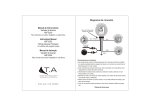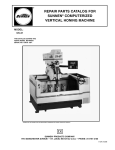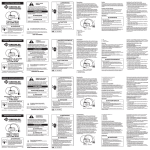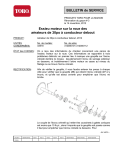Download 1771-6.5.17, Real Time Clock Module User Manual
Transcript
AllenBradley Real Time Clock Module (Cat. No. 1771-DC) User Manual Table of Contents Introduction . . . . . . . . . . . . . . . . . . . . . . . . . . . . . . . . . . . 11 General . . . . . . . . . . . . . . . . . . . . . . . . . . . . . . . . . . . . . . . . . . . Module Features . . . . . . . . . . . . . . . . . . . . . . . . . . . . . . . . . . . . Applications . . . . . . . . . . . . . . . . . . . . . . . . . . . . . . . . . . . . . . . . 11 11 12 Module Preparation and Installation . . . . . . . . . . . . . . . . . . 21 General . . . . . . . . . . . . . . . . . . . . . . . . . . . . . . . . . . . . . . . . . . . Panel Switches and Display . . . . . . . . . . . . . . . . . . . . . . . . . . . . Reset Switch and Programming Plug . . . . . . . . . . . . . . . . . . . . . . Battery Installation . . . . . . . . . . . . . . . . . . . . . . . . . . . . . . . . . . . Power Requirements . . . . . . . . . . . . . . . . . . . . . . . . . . . . . . . . . Chassis Location and Keying . . . . . . . . . . . . . . . . . . . . . . . . . . . Specifications . . . . . . . . . . . . . . . . . . . . . . . . . . . . . . . . . . . . . . 21 21 24 25 26 26 27 Operation and Programming . . . . . . . . . . . . . . . . . . . . . . . 31 General . . . . . . . . . . . . . . . . . . . . . . . . . . . . . . . . . . . . . . . . . . . Setting Time and Calendar from the Front Panel . . . . . . . . . . . . . . Displaying Time and Calendar from the Front Panel . . . . . . . . . . . Block Transfer Programming . . . . . . . . . . . . . . . . . . . . . . . . . . . . 31 31 34 34 Chapter 1 Introduction General The Real Time Clock Module (cat. no. 1771-DC) lets you or the PC processor read or set real time and date information. Current time and date information is block-transferred to and from the PC processor data table for control and reporting purposes. The clock module can be used with any of the following Allen-Bradley PLC Processors that have block transfer capability and use the 1771 I/O structure. Module Features You can set or read the time and date through the front panel pushbutton switches and 4-digit liquid crystal display (LCD) (Figure 1.1). You can program the PC processor to set or read time and calendar information automatically. Also, you can disable the time setting function to guard against unauthorized changes to an installed clock module. Figure 1.1 Real Time Clock Module Liquid Crystal Display Pushbutton Switches 17901 11 Chapter 1 Introduction Time and calendar functions are displayed as numbers. For example, Tuesday is designated by the module as the second day of the week. It is displayed as a 2. The year 1984 is displayed as 84. The hour is displayed in military 24 hour format, 3:00 pm = 15:00 hours. The clock module corrects for leap year. The clock module displays the time and date formatted by day of the week, year, month, day of the month, hours, minutes, and seconds. The clock module also measures time in milliseconds. The module maintains quartz crystal accuracy of 60 seconds per month and timer accuracy of +0.25ms, -1.25ms (non-cumulative) over the normal operating temperature of 0oC to +60oC. It uses a standard 9V alkaline battery for backup and reports self-diagnostic information whenever time and date information is read to the PC processor. Applications The accuracy and convenience of the clock module let you program many control and reporting applications such as: energy management process synchronization time and event correlation calendar scheduling accurate millisecond timing accurate timing of power failures accurate rate calculations You can use the clock module with other bulletin 1771 I/O modules in a variety of time-dependent applications. 12 Chapter 2 Module Preparation and Installation General The clock module generates accurate calendar and time data, performs continuous diagnostic tests, has battery backup to retain its functions during a power failure, responds to read and write block transfers from the PC processor, and has two buffer memories, each with a capacity of nine 16-bit words. The buffer write-only memory holds new calendar and time data received from the PC processor or entered from the front panel. The buffer read-only memory holds current calendar and time data that the module can transfer to the PC processor or display through the front panel LCD. Panel Switches and Display The front panel of the clock module contains two pushbutton switches and a 4-digit LCD (Figure 2.1). Figure 2.1 Pushbutton Switches and Display 14:06 17902 21 Chapter 2 Module Preparation and Installation Pushbutton Switches Two pushbutton switches labeled FUNCTION and DISPLAY are near the center of the front panel. They set time and calendar functions. The DISPLAY pushbutton switch changes the display of time and calendar information. These switches are described in sections titled “Setting Time and Calendar from the Front Panel” and “Displaying Time and Calendar from the Front Panel.” Display The LCD shows calendar, time, and diagnostic information. You can display calendar and time information in any one of the following formats (Figure 2.2): month with day of the month year with day of the week running time in minutes and seconds running time in hours and minutes The display of calendar and time information is covered in section titled “Displaying Time and Calendar from the Front Panel.” Figure 2.2 Display Formats Calendar Functions 701 22 Running Time Functions 05:37 July 1 Minutes : Seconds 83 5 14:06 1983 Friday Hours : Minutes (Colon Blinks) 11217 Chapter 2 Module Preparation and Installation Display of Diagnostics The module displays fault and alarm diagnostics. A battery low condition is indicated by the non-blinking display of a single dot beneath the colon in the center of the display (Figure 2.3). When the dot is first displayed, 24 hours of battery operation remain. Figure 2.3 Battery Low Indicator 14:06 . Battery Low Indicator (Does Not Blink) 11218 The module indicates that power has been restored following a total power failure (no battery backup) by blinking the display of eights in its LCD. The blinking eights display indicates that previous calendar and clock data have been lost, that the calendar and clock functions have ceased, and that the module’s calendar and clock should be reset. When a battery has been inserted in an unpowered clock module, the blinking eights display indicates that the module’s calendar and clock are ready to be set. Battery backup allows 100 hours of clock operation during power failures or brownouts. If the module detects an internal fault, the module’s clock will cease and a non-blinking error number will appear in the right-most digit space of the LCD. Error numbers are used during factory diagnosis and repair. In the event that an error number is displayed, proceed as follows: 1. Power-down the I/O chassis. CAUTION: Removing and inserting and I/O module when the I/O chassis is powered can result in possible damage to module circuitry. 2. Remove the clock module. 3. Press the reset switch (see “Reset Switch”). 23 Chapter 2 Module Preparation and Installation 4. Re-install the module. 5. Power-up the I/O chassis. 6. Set the clock and calendar, and start the clock using the procedure in section titled “Setting Time and Calendar from the Front Panel.” If the clock and calendar cannot be set or if the module’s clock will not start, return the clock module to your nearest authorized field service or sales office for repair. Reset Switch and Programming Plug The lower rear section of the clock module contains a reset switch and a programming plug (Figure 2.4). Figure 2.4 Reset Switch and Programming Plug Reset Switch Programming Plug 17903 Reset Switch You can reset the module’s clock and calendar functions by pressing and releasing the reset switch. The LCD displays blinking eights indicating that the module’s clock and calendar functions have ceased and are ready to be set. 24 Chapter 2 Module Preparation and Installation You can access the reset switch only when the module (with battery backup) has been removed from the I/O chassis. Pressing the reset switch has the same effect as temporarily disconnecting the battery. Programming Plug As a safeguard, you can prevent unauthorized changes to the module’s clock and calendar by means of a programming (jumper) plug. The plug disables the FUNCTION pushbutton switch on the front panel but does not disable the DISPLAY pushbutton switch. You insert the plug on two adjacent pins of a 3-pin assembly (Figure 2.5). Place the plug on the upper two pins when setting the clock and calendar functions and when you do not want to disable the FUNCTION pushbutton switch. Place the plug on the lower two pins to disable the FUNCTION pushbutton switch. Figure 2.5 Programming Plug Positions 3Pin Assembly 3Pin Assembly Programming Plug Programming Plug Plug Position for Setting Functions Battery Installation Plug Position Disables FUNCTION Switch 11219 The battery compartment is under the clock module’s lower front panel. To open the compartment, hook your finger over the upper edge of the hinged cover and pull the cover open. Connect the battery to the 9Vdc battery connector. When inserting the battery, be sure that the connecting wires are not pinched by the hinged cover as you snap the cover into place. Use a commercial 9Vdc alkaline battery such as Eveready 522 or Duracell 1064A for the backup battery. Battery life is 100 hours total for intermittent or prolonged power outage. Once the “battery low” 25 Chapter 2 Module Preparation and Installation indication is displayed and if backplane power is not restored, the battery must be changed within 24 hours or the module’s clock and calendar functions will cease. Do not change the battery during a power failure because clock and calendar data will be lost. For dependable backup operation, replace the battery annually or whenever the “battery low” indicator is illuminated or lights up. CAUTION: Do not replace the battery during a power outage or the clock and calendar functions will cease and the data will be lost. Power Requirements Under normal operation, the clock module draws all of its power, 350mA, from the I/O chassis backplane. During a power outage the backup battery powers only the module’s clock. Chassis Location and Keying Place the single-slot clock module in any bulletin 1771 I/O chassis I/O module slot. The clock module is not keyed. Other bulletin 1771 I/O modules can be inadvertently placed in the slot reserved for the clock module. However, the clock module cannot be placed in a keyed I/O slot. 26 Chapter 2 Module Preparation and Installation Specifications Accuracy • Total variation with time over the operating range of the module (0 to 600C): 60 seconds per month • Timing accuracy (independent of transfers): +0.25ms and 1.25ms Module Current Requirement • 350 mA max @ 5V DC from the backplane • 5.0mA max from backup battery during a power failure Backup Battery • Voltage: 9V DC • Type: Alkalinesuch as Duracell 1604A, Eveready 522, or equivalent • Life: One year standby when module is powered by the backplane; up to 100 hours during a power failure including 24 hours from battery low indication until the clock ceases Module Location • Any bulletin 1771 I/O chassis single I/O slot location Ambient Temperature Rating • 00C to 600C operational • 300C to 700C storage Humidity Rating • 5 to 85% (without condensation) Keying • None 27 Chapter 3 Operation and Programming General Calendar and time functions can either be set and read manually or be set and read by the PC processor. Upon initial installation of the module or upon recovery from a complete power failure (not battery backup), you must set the calendar and clock functions to start module operation. This chapter describes how you set and read the calendar and time functions from the front panel, and how you program block transfers so that calendar and time functions can be set and read by the PC processor. Setting Time and Calendar from the Front Panel The seven time and calendar functions are listed in the order that you set them. day of the week year month day of the month hours minutes seconds Set the time and calendar functions initially when the clock module is installed, or following a power failure if battery backup was inoperative. The display will blink eights when power is applied. The blinking eights display indicates that clock module functions are not operating but are waiting to be set. You can set or reset the time and calendar functions conveniently using the front panel FUNCTION and DISPLAY pushbutton switches. Briefly press the FUNCTION switch to advance the calendar-set or time-set function. Press the DISPLAY switch until the display reaches the setting you want to enter. The seven calendar and time functions are listed in the order that you initially set them (Table 3.A). The table includes the numerical range for each function such as 1 through 7 for day of the week, the initial display for each function, and an example setting for each function. Once you have set the clock and calendar, you can change any of the settings independently. 31 Chapter 3 Operation and Programming 1. Start the function selecting and setting procedure by pressing the FUNCTION pushbutton until the day of the week display is obtained. A1 appears in the right-most position on the display. If another initial display should appear (Table 3.A), use only the FUNCTION pushbutton switch to advance through the remaining functions until the day of the week display appears. Each time you press the FUNCTION pushbutton switch, hold it for a second or two until the display advances to the next function. Table 3.A Calendar and Time Functions Function Day of the Week Range 17 Initial Display [ 1] Example Setting Example Display Tuesday, day 2 [ 2] Year 0099 [0 0 ] 1984 [8 4 Month 112 [ 1 ] June, 6th month [ 6 Days of the Month 131 [ 13th day [ Hours 023 [ 0: 3:00pm = 15:00 hours [1 5: Minutes 059 [ :0 0] 45 minutes [ Seconds 059 [ :0 0] 27 seconds [ 01] ] ] ] 1 2] ] :4 5] :2 7] Press FUNCTION display set time in hrs:min (the colon is not blinking) [1 5: 4 5 ] Press DISPLAY a) displays date for several seconds [ 6 1 3] b) displays running time (the colon is blinking [1 5: 4 5 ] The module clock starts when the DISPLAY pushbutton switch is pressed. 2. 32 Enter the setting that you want by pressing the DISPLAY pushbutton switch until the display counts up to your desired setting, then release it. Chapter 3 Operation and Programming If you hold it too long and the count exceeds your setting, continue pressing the DISPLAY pushbutton until the count recycles through the entire range. 3. Continue selecting and setting the remaining calendar and time functions in this manner. When you complete a setting, press the FUNCTION pushbutton switch until the next initial display of a function appears. Then press the DISPLAY pushbutton switch until the desired setting is reached. Release it when the LCD displays your desired setting. The last two steps of the procedure must be completed before the clock module begins timing. 4. After selecting and setting the seconds function, press the FUNCTION pushbutton switch. The set time will be displayed in hours: minutes but the colon will not blink because the module’s clock is not running. 5. Press the DISPLAY pushbutton switch to start the module’s clock. The month and day are displayed. After several seconds, the display automatically changes to the current time displayed in hours: minutes. The colon blinks to indicate that the module’s clock is running. Important: The module’s clock starts the instant that the DISPLAY pushbutton switch is pressed (not released) during step 5. Important: You can change date settings and the hour setting without interrupting the module’s clock. However, the clock stops while you change the minute or second setting. Refer to the description of the wait bit (bit 03) in section titled “Status Word” for additional information on clock stoppage. Important: The time and calendar functions can also be set and the module started by a single write block transfer if you program the PC processor to perform this operation. 33 Chapter 3 Operation and Programming Setting the Module to a Time Standard You can set the clock module to a time standard such as the one broadcast by radio station WWV (2.5, 5.0, 10.0, 15.0 or 25.0MHz). Complete function-setting steps 1 through 4 to the next whole minute. As the last step, press the DISPLAY pushbutton switch the instant the time standard indicates the next whole minute. Displaying Time and Calendar from the Front Panel Running time in hours: minutes is displayed on the front panel LCD unless you select another calendar or time display. The three other displays (Figure 2.2) that you can select are: month with day of the month year with day of the week running time in minutes/seconds You can conveniently select the other running time and calendar displays with the front panel DISPLAY pushbutton switch. 6. Press the DISPLAY pushbutton switch until the next display is presented. The display remains as long as you depress the switch. Once released, calendar displays remain an additional three seconds, then revert to running time in hours: minutes. However, when the switch is released in either of the two running time displays, the display remains until you change it. 7. Select the next display by again pressing the DISPLAY pushbutton switch while the new display is still present (within the three second interval for calendar displays). In this manner you select, in turn, any one of the remaining three displays. Once you release the DISPLAY pushbutton switch in a calendar display, you allow the calendar display to revert to running time in hours: minutes if you do not press the pushbutton switch again. When you release the pushbutton switch in a running time display, the running time display remains. Block Transfer Programming 34 The clock module responds to read and write block transfer instructions. The PC processor reads current time and calendar data from the clock module using read block transfers. The PC processor writes calendar and clock settings to the clock module using write block transfers. Nine words are transferred in either case. Chapter 3 Operation and Programming WARNING: Use only Allen-Bradley authorized programming devices to program Allen-Bradley programmable controllers. Using unauthorized programming devices may result in unexpected operation, possibly causing equipment damage and/or injury to personnel. The Allen-Bradley Company will not be responsible or liable for any damages, whether direct, indirect, or consequential, arising out of the use of such unauthorized programming devices. Data Organization The same nine words are transferred in either a read or write operation (Table 3.B). During a write operation, status word 0 and millisecond word 8 are transferred with zero value. During a read operation, the PC processor monitors the clock module’s status as determined by status word 0, and reads the values of the remaining eight words including the millisecond word 8. When you program the block transfer instruction, set the block length to the default value or to nine. Any other block length can cause improper operation or prevent a block transfer. Table 3.B Data Organization Data Format Word Name Range Bit Numbers 17 14 13 10 07 04 03 00 01 Status Word 01 0 0 00BB B B B B2 1 Day of Week 17 0 0 0 D3 2 Year 0099 0 0 D D 3 Month 0112 0 0 D D 4 Day of Month 0131 0 0 D D 5 Hours 0023 0 0 D D 6 Minutes 0059 0 0 D D 7 Seconds 0059 0 0 D D 81 Milliseconds 000999 0 D D D 1 read only 2 B = binary bit 3 D = BCD digit 35 Chapter 3 Operation and Programming Status Word Six bits in the status word are used to report module diagnostics. The diagnostic word is included in each read block transfer of data to the PC processor. Bit functions of the status word are described as follows: Bit: 17-06 Name: None Description: Not used, set to zero. Bit: 05 Name: Module Uninitialized Description: Set (to 1) if the clock module loses power without battery backup. (Total power failure is also indicated by flashing eights in the LCD). Reset (to 0) when the clock module receives a write block transfer of time and/or calendar data from the PC processor or when you press the FUNCTION pushbutton switch to set the time from the front panel. You should program a rung to examine this bit to be sure that date and time data are valid before using the data. Bit: 04 Name: Battery Low Description: Set when the battery has approximately one day of battery life remaining, when the battery is dead, or when no battery is installed. Reset when a new battery is installed. You should program a rung to examine this bit to activate a visual and/or audible signal when the bit goes high. Bit: 03 Name: Wait Description: Set while you are setting the time or calendar from the front panel. Reset when the module’s clock starts. The clock module can be started manually from the front panel or by a write block transfer from the PC processor. If the module’s clock is running when you begin the time setting procedure for minutes or seconds, the clock stops and the module sets the wait bit when you press the DISPLAY pushbutton (step 2). If the module is powered but the clock is not running when you begin the time setting procedure for minutes or seconds, the module sets the wait bit when you press the FUNCTION pushbutton switch (step 1). 36 Chapter 3 Operation and Programming The module can receive a write block transfer from the PC processor when the wait bit is set, but the clock module will not start as a result. The wait bit will not be affected when changing the display of time or calendar from the front panel in steps 6 and 7. Bit: 02 Name: Invalid Value Description: Set if a write block transfer contains a time or calendar value out of range. If this happens, the module will substitute the lowest displayed value for the out of range value. Reset after a valid value is transferred in a subsequent write block transfer. Bit: 01 Name: Communication Error Description: Set when the module detects a PC communication fault during a write block transfer. If this happens, the clock module ignores the write block transfer and continues running with the previous data. Reset by a subsequent write block transfer after proper communication is restored. You should program a rung to examine this bit so that corrective action can be taken when a communication error occurs. Bit: 00 Name: Valid Time Description: Set when the clock module is running. Reset when the wait bit is set or when the module stops as a result of a total power failure. Sample Programs The format for programming block transfer depends on your PC processor. If you are using a controller with a 3-position keyswitch (Mini-PLC-2 or PLC-2/20 controller) use multiple get instructions. If you are using a controller with a 4-position keyswitch (Mini-PLC-2/15, PLC-2/30) or a PLC-3 family controller use block format instructions. The examples that follow use block format instructions. Refer to the Programming and Operations Manual of your processor for additional information on these instructions. Assume that the module is located in rack 1, module group 2, slot 0. 37 Chapter 3 Operation and Programming PLC-2 Family The control byte and status byte corresponding to the module’s address in the output and input image tables are at word addresses 0128 and 1128 (lower bytes), respectively, in this example. The addresses of the enable bit and done bit for the block transfer read instruction are 012/07 and 112/07, respectively. The addresses of the enable bit and done bit for the block transfer write instruction are 012/06 and 112/06, respectively. The following addresses are also used in the example (Figure 3.1): data address 0508 module address 1208 file words 1508-1608 (read) file words 2508-2608 (write) When rung 1 is true, the enable bit 012/17 is set. The data from the module is transferred into PC processor data table words 1508 through 1608. After the nine words of data are transferred to the PC processor, done bit 112/07 is set. When rung 2 is true, the enable bit 012/06 is set. Data to be transferred to the module is stored in the PC processor data table words 2508 through 2608. After the nine words of data are transferred to the module, done bit 112/06 is set. Figure 3.1 Block Transfer, PLC2 Family 1 BLOCK XFER READ DATA ADDR: MODULE ADDR: BLOCK LENGTH: FILE: 2 050 120 09 150160 BLOCK XFER WRITE DATA ADDR: MODULE ADDR: BLOCK LENGTH: FILE: 050 120 09 250260 012 EN 07 112 DN 07 012 EN 06 112 DN 06 11220 38 Chapter 3 Operation and Programming PLC-3 Family The PLC-3 block transfer control file is in binary file 2, words 0 through 9, in this example. Addresses of the control and status bits for the block transfer read instruction are FB002:0000/12(CNTL 12) for the enable bit, and FB002:0000/15(CNTL 15) for the done bit. Addresses of the control and status bits for the block transfer write instruction are FB002:0000/02(CNTL 02) for the enable bit, and FB002:0000/05(CNTL 05) for the done bit. Store block transfer read and write data in any two available decimal files designated by the appropriate section, file number, and starting word address such as FD010:0000 for read data, and FD011:0000 for write data (Figure 3.2). When rung 1 is true, the enable bit CNTL 12 is set. The data from the module is transferred into the PC processor data table in decimal file 10 words 0 through 8. After the nine words of data are transferred to the PC processor, the done bit CNTL 15 is set. When rung 2 is true, the enable bit CNTL 02 is set. Data to be transferred to the module is stored in decimal file 11 words 0 through 8. After the nine words of data are transferred to the module, done bit CNTL 05 is set. Figure 3.2 Block Transfer, PLC3 Family 1 BTR BLOCK XFER READ RACK: GROUP: MODULE: DATA: LENGTH = CNTL: 2 012 2 0 = LOW FD010:0000 09 FB002:0000 BTW BLOCK XFER WRITE RACK: GROUP: MODULE: DATA: LENGTH = CNTL: 012 2 0 = LOW FD011:0000 09 FB002:0000 CNTL EN 12 CNTL DN 15 CNTL ER 13 CNTL EN 02 CNTL DN 05 CNTL ER 03 11257 39 Chapter 3 Operation and Programming Programming Considerations Additional programming rungs should be added at your discretion. Data from the module should be stored temporarily in a buffer file until the block transfer done bit is set indicating a valid transfer. Program a boundary word after the last block transfer data address to prevent the PC processor from searching further in the accumulated value area for block transfer data addresses (PLC-2 Family). Program a watchdog timer and an indicating device to detect and signal the possible loss of communication with block transfer modules. Block Transfer Timing Only one read or write block transfer can occur at a time. When the PC processor is reading clock, calendar, and diagnostic data, another block transfer is inhibited for 1.6ms until the time changes and the module’s buffer memory is updated. When the PC processor is writing new clock and calendar settings to the module, subsequent block transfers are inhibited for 2.0ms until the new calendar and clock values are set. The module time of 2.0ms maximum for a block transfer is shorter than the PC processor scan time. Therefore, the module is ready whenever it receives a request to transfer data. The clock module continuously stores time and calendar data in its buffer memory. The moment it receives a request for a block transfer from the PC processor, it latches the data in memory. The data transferred to the PC processor is the data that the module latched when it received the block transfer request. The clock module can be used as a millisecond timer allowing the PC processor to perform rate calculations. When you use the clock module as a millisecond timer, you can achieve accurate differential times by starting and stopping the clock in the same scans that the PC processor reads, respectively, the initial and final measured values. This is done by enabling the timer with a write block transfer in the same scan that the PC processor reads the initial measured value, and reading the timer’s accumulated value with a read block transfer in the same scan that the PC processor reads the final measured value. Locate the clock module in a slot adjacent to the I/O module from which the measured values are read. The differential accuracy is not affected by block transfer delays when operating in a local I/O system. 310 Chapter 3 Operation and Programming The time required for a block transfer depends on factors independent of the clock module. The delay before the next transfer depends typically on the processor scan time, the number of block transfer instructions enabled simultaneously in the same scan, the number of words transferred, system layout for a PLC-3 controller, and whether the PLC-2 family system contains local or remote I/O. Remote I/O generally takes longer than local I/O. 311 Index A Accuracy, See Specifications, 27 L Location in Chassis, 26 Applications, 12 B Battery Installation, 25 Specifications, 27 P PC Processor Compatibility, 11 Power Failure Indication, 23 Power Requirements, 26 Block Transfer Programming, 34 Timing, 310 Programming Block Transfer, Considerations, PLC 2 Family, PLC 3 Family, Buffer Memory, 21 Programming Plug, 25 Battery Low Indication, 23 34 310 38 39 Pushbuttom Switches, 22 D Data Organization, 35 R Diagnostic Display, 23 Rate Calculations, 310 Display Formats, 22 Reset Procedure, 24 Reset Switch, 24 F Features, 11 Functions Displaying from Front Panel, 34 Setting from Front Panel, 31 Setting to a Standard, 34 K Keying, 26 S Securing the Settings, 25 Specifications, 27 Starting the Clock, 33 Status Word, 36 AllenBradley, a Rockwell Automation Business, has been helping its customers improve pro ductivity and quality for more than 90 years. We design, manufacture and support a broad range of automation products worldwide. They include logic processors, power and motion control devices, operator interfaces, sensors and a variety of software. Rockwell is one of the worlds leading technology companies. Worldwide representation. Argentina • Australia • Austria • Bahrain • Belgium • Brazil • Bulgaria • Canada • Chile • China, PRC • Colombia • Costa Rica • Croatia • Cyprus • Czech Republic • Denmark • Ecuador • Egypt • El Salvador • Finland • France • Germany • Greece • Guatemala • Honduras • Hong Kong • Hungary • Iceland • India • Indonesia • Ireland • Israel • Italy • Jamaica • Japan • Jordan • Korea • Kuwait • Lebanon • Malaysia • Mexico • Netherlands • New Zealand • Norway • Pakistan • Peru • Philippines • Poland • Portugal • Puerto Rico • Qatar • Romania • RussiaCIS • Saudi Arabia • Singapore • Slovakia • Slovenia • South Africa, Republic • Spain • Sweden • Switzerland • Taiwan • Thailand • Turkey • United Arab Emirates • United Kingdom • United States • Uruguay • Venezuela • Yugoslavia AllenBradley Headquarters, 1201 South Second Street, Milwaukee, WI 53204 USA, Tel: (1) 414 3822000 Fax: (1) 414 3824444 Publication 1771-6.5.17 - February, 1986 Supersedes 1771-824 - September, 1983 1986 Publication 1771-6.5.17 - February, PN 955099-40 Copyright 1986 AllenBradley Company, Inc. Printed in USA

































